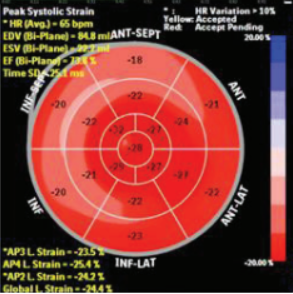Objective: To evaluate whether there is any difference between radiographic axial spondyloarthritis (r-axSpA), also termed ankylosing spondylitis (AS), and non-radiographic (nr-) axSpA, with respect to subclinial myocardial dysfunction using speckle tracking echocardiography (STE).
Methods: This was a cross-sectional case control study. We included 72 patients with AS, 38 patients with nr-axSpA, and 56 age-matched healthy subjects. Patients with cardiac disease and cardiac risk factors affecting STE were excluded. The disease burden evaluated by the BASDAI, BASFI, BAS-G, and ASAS-HI scores were comparable in both the r- and nr-axSpA groups. A detailed echocardiographic examination including the M-mode, Doppler, and STE was applied to whole study population.
Results: Duration of the disease, the use of an anti-TNFα agent, and CRP levels were higher in patients with AS. Although the AS, nr-axSpA, and control groups had similar ejection fraction values (59±5.2, 60±4.6, 60±4.6, respectively, and p=0.499), the global longitudinal peak systolic strain (GLS) (20.5±3.3, 21.1±3.5, and 22.3±2.4, respectively, and p<0.05) was different between the groups. In a post-hoc analysis, GLS was not different between the nr-axSpA and control groups, and it was significantly lower in patients with AS. In the univariate analysis, peripheral arthritis (p=0.035) and age (p=0.032) were correlated with GLS. A multivariate regression analysis demonstrated that peripheral arthritis (p=0.009) was the only independent GLS predictor.
Conclusion: Subclinical myocardial dysfunction as assessed by GLS was present in AS, but not in nr-axSpA patients. Thus, GLS could be used as a differentiating factor between radiographic and nr-axSpA patients.
Cite this article as: Emren SV, Gerçik O, Özdemir E, Solmaz D, Eren N, Şimşek EÇ, et al. Evaluation of subclinical myocardial dysfunction using speckle tracking echocardiography in patients with radiographic and non-radiographic axial spondyloarthritis. Eur J Rheumatol 2020; 7(1): 9-15.



.png)
